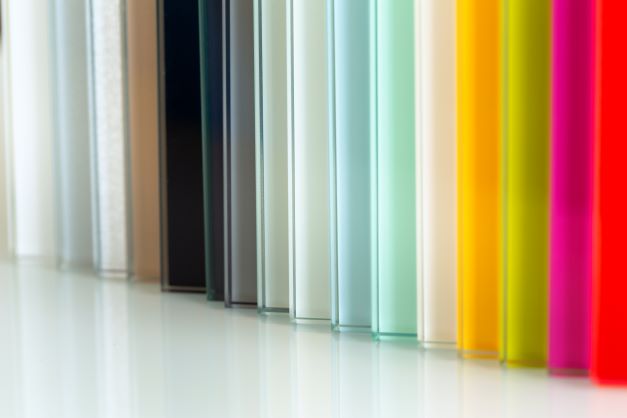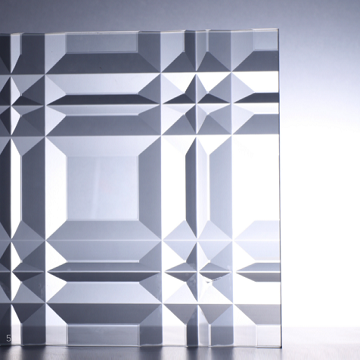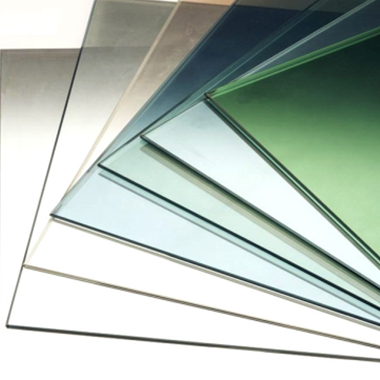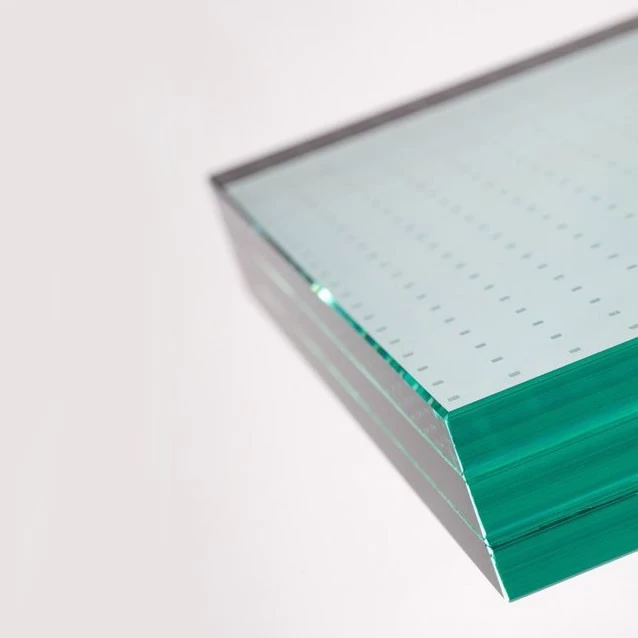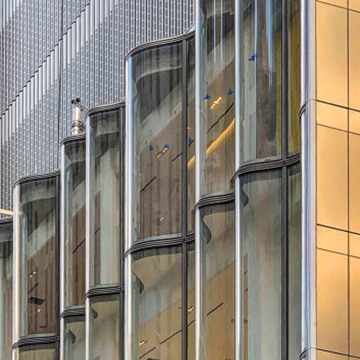Experiments and guidance on glass breaking out in fires
Laminated Glass
The earliest guidance to be found in the literature on the question of when glass breaks out in fires comes from the Russian researcher Roytman who notes that a room gas temperature of around 300°C is needed to lead to glass breakage. The research base for this conclusion is unclear, however.
Hassani, Shields, and Silcock conducted a series of experiments in a half-scale fire test room using 0.9 x 1.6 m single-glazed windows where they created a natural top-to-bottom temperature gradient in the room and in the glass. At the time the first crack occurred in 4 or 6 javascript:MM thick glass panes, gas temperatures in the upper layer of 323 - 467°C were recorded. By the end of their 20 min tests, gas temperatures were at ca. 500°C. Yet in only 1 of 6 tests was there any fall-out of glass. Temperature differences between the glass exposed surface and the shielded portion ranged between 125°C to 146°C at the time of crack initiation. These temperatures were about twice that predicted from the no-vertical-gradient theories. The authors do not give the exact room fire temperature at which the glass fall-out began in the one test where this occurred, but this had be higher than 431°C (crack initiation) and lower than ca. 450°C (end of test). One can put these data together, then, to conclude that at a room gas temperature of around 450°C the probability is 1/6 for glass to break out. The same authors conducted further tests using a room with two windows glazed with 6 javascript:MM thick panes. In two tests, fire temperatures of 400 - 500°C in the vicinity of the glass resulted in no fall-out of glass. In the third test, one pane fell out at a gas temperature of 500°C. The gas temperature when the second window's pane fell out was also about 500°C, but some 8.5 more minutes had gone by, the temperature being relatively steady in that time.
The newest experimental results concerning glass exposed to a uniform hot temperature come from the Building Research Institute (BRI) of Japan. In that study, researchers used a large-scale high-temperature door-leakage testing apparatus that resembles a large muffle furnace. Only single-glazed, 3 javascript:MM thick window glass was studied. For this type of glass, however, enough tests were run so that a probability graph could be plotted. These researchers' results are presented in terms of a probability of glass breaking out, as a function of temperature rise above ambient. The figure below shows the results.
The Gaussian fit that can correlate this data corresponds to a mean temperature rise of 340°C, and a standard deviation of 50°C. Thus, the BRI results are somewhere in between the two earlier values.
The Loss Prevention Council of the UK studied room fires which were providing fire exposure to a multi-story façade test rig. Double-glazed windows were examined, with each pane being 6 javascript:MM thick. Using 3 MW wood crib fires, it was found that temperatures of at least 600ºC had to be sustained for 8 - 10 min before glass started falling out sufficiently so that fire venting would occur. When tests were repeated using a fully-furnished office room arrangement, however, glass broke out at 5 min after the start of fire. In that test, the temperature was also about 600ºC at the time of failure, but occurred ijavascript:MMediately as the temperature was reached. Thus, the findings lead to the conclusion that double-glazed windows using 6 javascript:MM thick glass will fail at ca. 600ºC and that, if the fuel load is significant, the failure may be expected to occur essentially at the instant that 600ºC is first reached.
Shields, Silcock and Hassani exposed two sizes of double-glazed windows to room fires. The glass thickness was 6 javascript:MM. The room fire reached a peak of 750ºC and no glazing fell out up to the peak. However, during the decay part of the fire, in one of 3 tests with the larger-size window (0.8 x 1.0 m) fall-out of the inner pane occurred at 21 min, when the temperature had dropped to 500ºC. Glass did not ever fall out from the outer pane, nor did any fall-out occur in the smaller (0.8 x 0.5 m) window, nor did any fall-out occur in the other two tests. The same authors later tested a room having a wall with twelve1.5 x 1.5 m double-glazed windows. The test record is very brief, but it is indicated that total failure of the first window occurred when the gas temperature was at 350ºC; it is not clear what the temperatures were for the fall-out of the subsequent windows.
For radiant exposure, Cohen and Wilson reported on an interesting series of experiments simulating flame exposure from a wildland fire. They examined small (0.61 x 0.61 m) and large (0.91 x 1.5 m) panes, single- and double-glazed. They also repeated the tests with tempered glass and with double-glazed windows. For the small windows, at their lowest heat flux, 9.3 kW m2, all windows cracked, but no glass fell out. Even at the highest flux of 17.7 kW m2 panes did not fall out. For the larger size panes, at fluxes of 16.2 to 50.3 kW m2, at least one out of 3 test specimens exhibited fall-out. Tempered glass, by contrast, showed no cracking at tests up to 29.2 kW m2 in the larger size. The authors also did tests on double-glazed windows, which showed better performance. In experiments with large-size double-glazed windows (non-tempered), they found that fluxes between 20 and 30 kW m2 were required to cause fall-out in both panes.
Harada et al. tested 3 javascript:MM thick float glass (specimen size: 0.5 by 0.5 m) by subjecting them to various heat fluxes from a test furnace. Below 8 kW m-2, no significant fallout occurred, but for a heat flux of 9 kW m-2, in some cases 8 - 24% of the specimen area fell out. Edge constraint did not affect the results.
Additional data are available from the NRCC study, where heat-strengthened and tempered glass (unspecified thickness) was found not to break at an irradiance of 43 kW m-2. The latter heat flux corresponded to 350ºC on the exposed face and 300ºC on the unexposed face. Thus, this appears to extend Cohen's data point of 29.2 kW m-2 for non-breakage to 43 kW m-2, without actually determining the point at which breakage and fall-out do occur.
Other types of glass
The published studies have dealt primarily with thin panes of annealed or tempered soda glass. Yet, there are many other types of glass to consider. Some very thick plate glass is used in many cojavascript:MMercial buildings. Plate glass of 6 javascript:MM thickness was found to shatter after a significant time (7 min) of exposure to a radiant heat flux of 23 kW m-2; otherwise information is not available on its performance. Automotive glass is another category which has not been studied in a systematic way. Finally, there are various fire-resistive glasses. The oldest category of the latter is wire glass. Nowadays, several types of patented fire-resistive glasses also exist which are not wired glass. These are usually multi-layered structures, generally involving some polymeric inner layers. Fire-resistive glasses will normally be accompanied by a laboratory report of the endurance period. Such glasses can be assumed to have no ventilation flow until after their failure time.
Effect of window frame type
Actual fall-out of glass from windows is also influenced by the window-frame material. Mowrer [11] found that vinyl-frame windows tended to show a failure of the frame (e.g., the whole assembly collapsing) before significant fall-out of glazing. Vinyl frame failures were observed when heat fluxes came up to the range of 8 to 16 kW m-2. By contrast, McArthur found that glass in aluminum-framed windows showed a tendency to survive longer than did glass in conventional wood-frame windows.
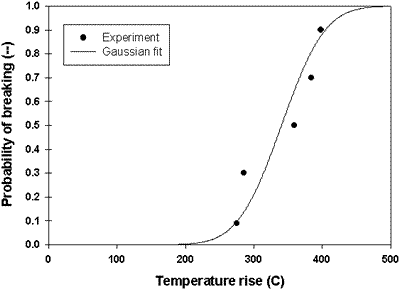
Conclusions
A theory exists for predicting the occurrence of the first crack in glazing, but this is not directly relevant to fire ventilation. The above brief review of the literature shows that it is, in fact, very difficult to predict when glass will actually break enough to fall out in a real fire. The Russian recojavascript:MMendation of 300°C appears to be a reasonable lower bound. The new Japanese study can be taken to imply that 3 javascript:MM window glass will break around 340°C. For thicker, 4-6 javascript:MM glass, the mean temperature of breakage would appear to be in excess of 450°C, although the difference between the thinner and the thicker glass results seems rather larger than one would surmise. Double-glazed windows using 6 javascript:MM glass can be expected to break out at about 600ºC. Tempered-glass in not likely to break out until after room flashover has been reached.
In terms of external fires, at a heat flux of 9 kW m2 some experimental results on ordinary glass showed the possibility of significant fallout. Other studies found that higher heat fluxes were needed, thus 9 kW m-2 appears to be a conservative, but realistic lower bound. Double-glazed windows can resist approximately 25 kW m2 without fall-out. Tempered glass is able to resist fluxes of 43 kW m2, at least under some conditions.
Factors such as window size, frame type, glass thickness, glass defects, and vertical temperature gradient may all be expected to have an effect on glass fall-out. Over-pressure due to gas explosions is an obvious glass failure mechanism. Yet, normal fires do show pressure variations and these could potentially affect the failure of glass panes. All of these factors deserve some more study to obtain useful, quantitative guidance.
The above review has dealt only with the role of glass breakage in fire ventilation. A number of other aspects of glass breakage are important to fire investigators; these have been well presented by Schudel.
Wallkingdon Glass provides first-class products and services to exceed customer expectations. No matter what your project needs—from external high-rise windows to large-capacity glass in storefronts or showrooms, please contact us through the following ways: enquiry@wallkingdonglass.com


